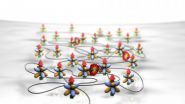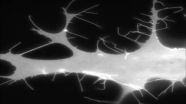(Press-News.org) The team of Francesca Ferlaino, Institute for Experimental Physics of the University of Innsbruck, Austria, has experimentally shown chaotic behavior of particles in a quantum gas. "For the first time we have been able to observe quantum chaos in the scattering behavior of ultracold atoms," says an excited Ferlaino. The physicists used random matrix theory to confirm their results, thus asserting the universal character of this statistical theory. Nobel laureate Eugene Wigner formulated random matrix theory to describe complex systems in the 1950s. Although interactions between neutrons with atomic nuclei were not well-known then, Wigner was able to reliably predict properties of complex spectra by using random matrices. Today random matrix theory is applied broadly not only in physics but also in number theory, wireless information technology and risk management models in finance to name only a few fields of application. In the Bohigas-Giannoni-Schmit conjecture random matrix theory has been connected to chaotic behavior in quantum mechanical systems. Catalan physicist Oriol Bohigas, who passed away last year, can be considered the father of quantum chaos research.
Chaos in the quantum world
To observe quantum chaos, the physicists in Innsbruck cool erbium atoms to a few hundred nanokelvin and load them in an optical dipole trap composed of laser beams. They then influence the scattering behavior of the particles by using a magnetic field. After holding the atoms in the trap for 400 milliseconds, the researchers record the atom number remaining in the trap. Thus, the scientists are able to determine at which magnetic field two atoms are coupled to form a weakly-bound molecule. At this magnetic field, so-called Fano-Feshbach resonances emerge. After varying the magnetic field in each experimental cycle and repeating the experiment 14,000 times, the physicists identified 200 resonances. "We were fascinated by how many resonances of this type we found. This is unprecedented in the physics of ultracold quantum gases," says Francesca Ferlaino's team member Albert Frisch. To explain the high density of resonances, the researchers used statistical methods. By using Wigner's random matrix theory the scientists are able to show that different molecular levels are coupled. This has also been confirmed by computer simulations conducted by Svetlana Kotochigova's research group at Temple University in Philadelphia, Pennsylvania, USA. "The particular properties of erbium cause a highly complex coupling behavior between the particles, which can be described as chaotic," explains Ferlaino. Erbium is relatively heavy and highly magnetic, which leads to anisotropic interaction between atoms. "The electron shell of these atoms do not resemble spherical shells but are highly deformed," explains Albert Frisch. "Therefore, the type of interaction between two erbium atoms is significantly different from other quantum gases that have been investigated so far."
Studying chaos experimentally
In contrast to everyday speech, chaos does not mean disorder for the physicists but rather a well-ordered system that, due to its complexity, shows random behavior. Ferlaino is excited about their breakthrough: "We have created an experiment that provides a controlled environment to study chaotic processes. We cannot characterize the behavior of single atoms in our experiment. However, by using statistical methods, we can describe the behavior of all particles." She compares the method with sociology, which studies the behavior of a bigger community of people, whereas psychology describes the relations between individuals. This work also provides new inroads to the investigation of ultracold gases and, thus, ultracold chemistry." Ferlaino is convinced: "Our work represents a turning point in the world of ultracold gases."
INFORMATION:
The experiment and statistical analysis were carried out at the Institute for Experimental Physics at the University of Innsbruck. Theoretical support was provided by John L. Bohn from the Joint Institute for Laboratory Astrophysics in Boulder, Colorado, USA and the team of Svetlana Kotochigova at Temple University in Philadelphia, Pennsylvania, USA. The Austrian researchers are supported by the Austrian Science Fund FWF and the European Research Council (ERC).
Publication: Quantum Chaos in Ultracold Collisions of Erbium. Frisch A, Mark M, Aikawa K, and Ferlaino F, Bohn JL, Makrides C, Petrov A, and Kotochigova S. Nature 2014 DOI: 10.1038/nature13137 [arXiv:1312.1972v1, http://arxiv.org/abs/1312.1972v1]
Quantum chaos in ultracold gas discovered
2014-03-12
ELSE PRESS RELEASES FROM THIS DATE:
Key heart-failure culprit discovered
2014-03-12
SAN DIEGO, Calif., March 12, 2014 - A team of cardiovascular researchers from Sanford-Burnham Medical Research Institute (Sanford-Burnham), the Cardiovascular Research Center at Icahn School of Medicine at Mount Sinai, and the University of California, San Diego have identified a small but powerful new player in the onset and progression of heart failure. Their findings, published in the journal Nature on March 12, also show how they successfully blocked the newly discovered culprit to halt the debilitating and chronic life-threatening condition in its tracks.
In the ...
Protein key to cell motility has implications for stopping cancer metastasis
2014-03-12
VIDEO:
Aberrant filopodia are induced by co-expression of fluorescently labeled Cdc42 and non-fluorescent IRSp53. Fluorescence shows the cell shape, because Cdc42 localizes to the plasma membrane.
Click here for more information.
PHILADELPHIA - "Cell movement is the basic recipe of life, and all cells have the capacity to move," says Roberto Dominguez, PhD, professor of Physiology at the Perelman School of Medicine, University of Pennsylvania. Motility – albeit on a cellular spatial ...
Countering the caregiver placebo effect
2014-03-12
How do you know that your pet is benefiting from its pain medication? A new clinical trial design from North Carolina State University researchers could help overcome pet owners' unconscious observation bias and determine whether the drugs they test are effective.
When animals are recruited for clinical trials, particularly for pain medications, researchers must rely on owner observation to determine whether the medication is working. Sounds simple enough, but as it turns out, human and animal behavior can affect the results.
All clinical trials have a "control" ...
'Ultracold' molecules promising for quantum computing, simulation
2014-03-12
WEST LAFAYETTE, Ind. – Researchers have created a new type of "ultracold" molecule, using lasers to cool atoms nearly to absolute zero and then gluing them together, a technology that might be applied to quantum computing, precise sensors and advanced simulations.
"It sounds counterintuitive, but you can use lasers to take away the kinetic energy, resulting in radical cooling," said Yong P. Chen, an associate professor of physics and electrical and computer engineering at Purdue University.
Physicists are using lasers to achieve such extreme cooling, reducing the temperature ...
Turing's theory of morphogenesis validated 60 years after his death
2014-03-12
PITTSBURGH—British mathematician Alan Turing's accomplishments in computer science are well known—he's the man who cracked the German Enigma code, expediting the Allies' victory in World War II. He also had a tremendous impact on biology and chemistry. In his only paper in biology, Turing proposed a theory of morphogenesis, or how identical copies of a single cell differentiate, for example, into an organism with arms and legs, a head and tail.
Now, 60 years after Turing's death, researchers from the University of Pittsburgh and Brandeis University have provided the ...
Large study identifies the exact gut bacteria involved in Crohn's disease
2014-03-12
While the causes of Crohn's disease are not well understood, recent research indicates an important role for an abnormal immune response to the microbes that live in the gut. In the largest study of its kind, researchers have now identified specific bacteria that are abnormally increased or decreased when Crohn's disease develops. The findings, which appear in the March 12 issue of the Cell Press journal Cell Host & Microbe, suggest which microbial metabolites could be targeted to treat patients with this chronic and currently incurable inflammatory bowel disease.
Twenty-eight ...
Newly diagnosed Crohn's disease patients show imbalance in intestinal microbial population
2014-03-12
A multi-institutional study led by investigators from Massachusetts General Hospital (MGH) and the Broad Institute has identified how the intestinal microbial population of newly diagnosed Crohn's disease patients differs from that of individuals free of inflammatory bowel disease (IBD). In their paper in the March 12 issue of Cell Host and Microbe, the researchers report that Crohn's patients showed increased levels of harmful bacteria and reduced levels of the beneficial bacteria usually found in a healthy gastrointestinal tract.
Several studies have suggested that ...
Missing link in plant immunity identified
2014-03-12
After a 30-year search, scientists have uncovered how an enzyme critical to plants' rapid immune response against microbes is activated.
"The insights will open up new ways to improve disease resistance and stress tolerance in plants," says Professor Cyril Zipfel of The Sainsbury Laboratory in Norwich.
The enzyme, the NAPDH oxidase RBOHD, triggers a rapid generation of signalling molecules derived from oxygen that are believed to be detrimental to microbial growth. The newly-discovered way this enzyme is activated, by a protein (called BIK1) fills a gap in how plants ...
Microbes help to battle infection
2014-03-12
The human relationship with microbial life is complicated. At almost any supermarket, you can pick up both antibacterial soap and probiotic yogurt during the same shopping trip. Although there are types of bacteria that can make us sick, Caltech professor of biology and biological engineering Sarkis Mazmanian and his team are most interested in the thousands of other bacteria—many already living inside our bodies—that actually keep us healthy. His past work in mice has shown that restoring populations of beneficial bacteria can help alleviate the symptoms of inflammatory ...
Study finds increased gender variance in children with autism and ADHD
2014-03-12
Washington, DC— John F. Strang, PsyD, a pediatric neuropsychologist at Children's National Health System, and colleagues, found that children with autism spectrum disorders (ASD) or attention deficit hyperactivity disorder (ADHD) were more likely to exhibit gender variance, the wish to be the other gender, than children with no neurodevelopmental disorder, or a medical neurodevelopmental disorder such as epilepsy or neurofibromatosis.
The study, titled "Increased Gender Variance in Autism Spectrum Disorders and Attention Deficit Hyperactivity Disorder" was published ...





